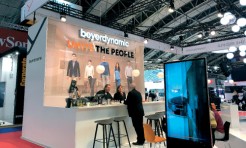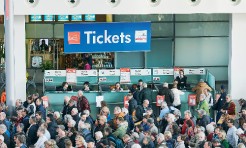How can exhibition visitors be reached with multi-touch applications?
Multi-touch systems provide exhibitors at exhibitions with numerous options. There are simple applications that can be designed in relation to the firm and a high degree of attention at a good price-performance relationship.

Expert: Matthias Woggon
Managing Director
eyefactive
Wedel
Long-distance effect
That interactive actions are visible at a distance in the exhibition hall is a desired (side) effect. A multi-touch table at an exhibition stand almost always becomes an eye-catcher. It produces the “wow” effect and often groups of people gather around it, which in turn make others curious and attract them. Exhibitors can reinforce this attraction with music or sound, or when displays are sued as stand walls.
Intuitive control
The iPhone does not need instructions. A similar principle is at the root of the multi-touch applications: They are supposed to be as simple as possible. Whether transmitting knowledge or games – the uses has to immediately understand what can be done. This intuitive control has been learned by most people, thanks to the spread and use of smartphones.

Effective marketing
What is new is the multi-user approach. The exhibitor only needs a system, instead of several terminals. In this way several people can use the application simultaneously. No one is lost, because the only terminal is occupied. In addition, direct contact with potential customers can be achieved – within the limits of legal restrictions – and performance can be measured, such as interactive contests or surveys. Info materials can also be retrieved by the input of the email address. Receiving digital documents reinforces among the receivers the effect of multi-touch applications beyond the exhibition presentation.
Novel options
Multi-touch systems create interactive possibilities, which would not be possible or only to a limited extent with normal PCs – for example, putting together machines for a complete production line, working out financing with customers, or designing an exhibition stand together.
Modular system
The visualisation on the display is beamed by several projectors. In contrast to LED or TFT technologies, cordless as well as round display surfaces can be achieved. In this manner design options arise – the multi-touch tables can be adjusted to existing or planned design of the exhibitor’s stand. The touch recognition is done via cameras, which can transmit innumerable touch points or objects. Moreover, the display surfaces are extremely robust against impacts or liquids, since the technology is located behind the screen.
Visualising products
For reasons of space, transport, or cost, not all the products of an exhibitor can always be presented at the exhibition. Multi-touch systems help to make exhibits that not showable or complex services simply and intuitively understandable.
Manageable costs
The App Store offers a selection of multiuser apps for a variety of uses. With the use of a type of content management system customers can adjust the apps individually to their own design and integrate multimedial content – quickly, simply, and without any programming knowledge. All apps can be tested for free as a download on your PC or notebook (www.multitouch-appstore.com). Since the apps have already been developed, their use is comparably cheap. Then there are the costs for the purchase or rental of the “hardware” (a box/ several boxes with a projector, and a camera), an appearance according to the corporate design, and accessory costs such as transport. A “sensible” multi-touch application for a four-day exhibition can be had starting approximately at 5,000 Euros. It gets more expensive when developments or programming are done solely for the exhibition presentation. The costs will then grow due to the additional investments.
The company eyefactive was founded by the media information scientists Johannes Ryks and Matthias Woggon in mid-2009. It arose as a spin-off from the University of Applied Sciences in Wedel. An initial student project already developed a prototype here at the beginning of 2007. Multi-touch technology was at this time almost unknown.
This article was published in TFI issue 2/2014
Share in Facebook, Twitter or Google+:
TFI - Trade Fairs International - The International Trade Fair Magazine.
© 2006 - 2024 by TFI-Verlagsgesellschaft mbH. All rights reserved. TFI-Verlagsgesellschaft mbH shall accept no responsibility for the contents of external links and other contents.
TFI-Know-how
-
What to do when things go wrong at virtual or in-person events?

In the event world, it’s simply part of life if things don’t work out as planned.
-
How can networking be made to work at online events?

Networking typically happens at real, in-person events. But it’s also possible to do it online; it just works a little differently. There are various options available to organisers.
-
How can exhibitors stand out at trade fairs?

New products and a well-conceived stand design are not the only drivers for a successful presence. Many other factors are also important, but trade fair planners often lose sight of them.
-
How can industry decision-makers be reached online?

Trade fairs and trade fair companies need to constantly further develop, become more agile and flexible and offer services all year round. New, digital offerings are very important here. With its TrustedTargeting technology, Messe München offers its customers access to leading business-to-business decision-makers on the Internet.


